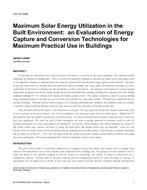Description
To maximize the utilization of solar energy in the built environment, it is necessary to take greatest advantage of the radiation available falling upon the footprint of a building space. There is a need for cost competitive technologies to maximize the capture of this solar energy, as well as cost competitive technologies to optimally utilize this energy once captured, while also minimizing energy supply and load mismatch. This paper discusses the initial results of a building model and comparative analysis of multiple solar energy capture and utilization technologies, in various combinations, for the purpose of identifying the most cost effective or carbon neutral options. An integrated, systems approach is needed to develop designs which incorporate solar-thermal cooling, heating and possibly dehumidification technologies including their integration with other building components including HVAC, domestic water heating, and building envelope systems. This analysis incorporates a model of a typical building energy consumption profile over the course of a year in relation to the available solar energy input available. The model can be adjusted for the size and type of building. Thermally activated cooling techniques such as desiccant dehumidification, adsorption, and absorption options are included. A sensitivity analysis is presented looking at electricity rates, natural gas unit cost, and carbon cost (or future carbon risk).
From the initial results of this analysis, a few observations can be made. The large capital cost used for solar thermal systems makes them the least economical of all systems reviewed. One of the best performers is the natural gas engine driven heat pump system. Adding solar PV adds significant value and should be considered for any building system. Air source and ground source heat pumps systems fair well as natural gas prices raise significantly. This model can lead to further investigation into weak or missing components or subsystems needed to make the maximum cost effective use of solar energy falling on the building site. For instance, if more economical solar thermal equipment was available to fully capture summer solar radiation and convert to cooling, this would make solar thermal systems more cost competitive. Lower cost solar thermal systems are needed, perhaps directly and effectively driving thermally activated cooling systems, if solar thermal is to compete economically with the falling cost of solar PV. Next steps will involve further fine tuning of the model, including refining capital cost estimates and adding other system combinations. The energy modeling provides a high level comparative review of various options.
Citation: ASHRAE Papers: 2015 ASHRAE Annual Conference, Chicago, IL
Product Details
- Published:
- 2015
- Number of Pages:
- 8
- File Size:
- 1 file , 2 MB
- Product Code(s):
- D-CH-15-C029




